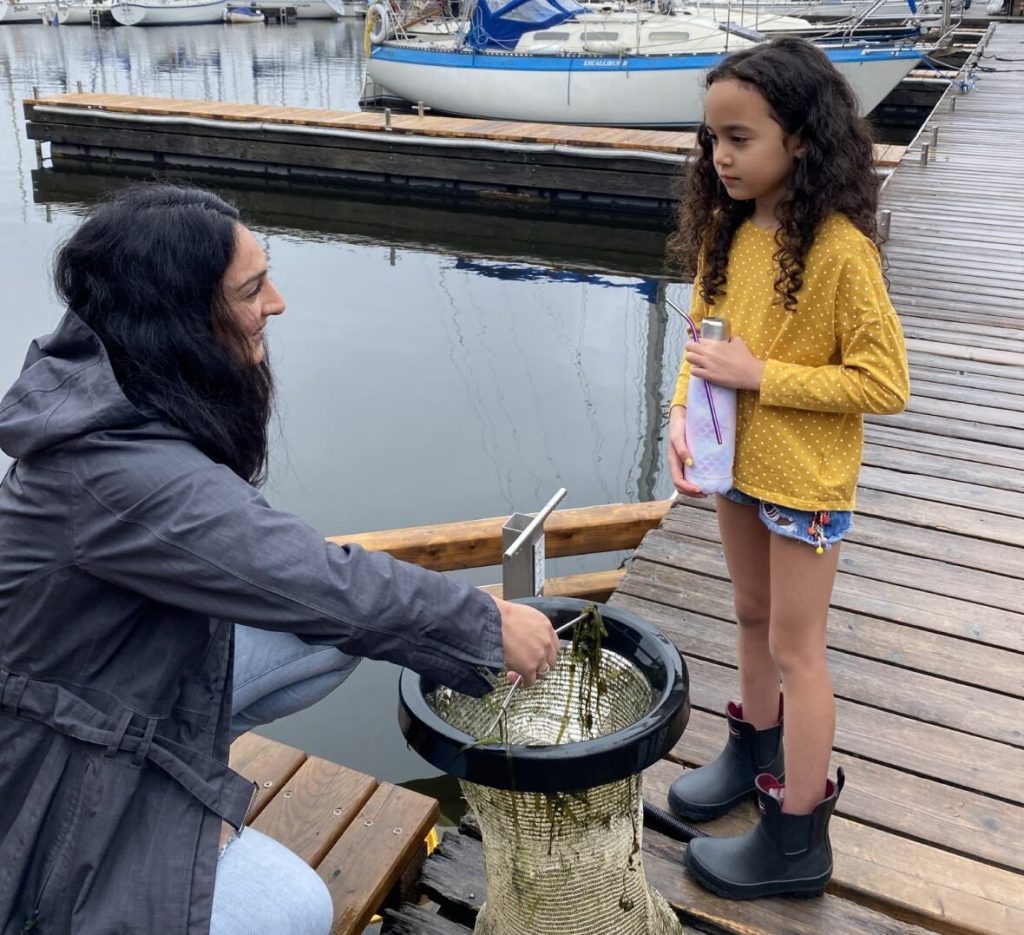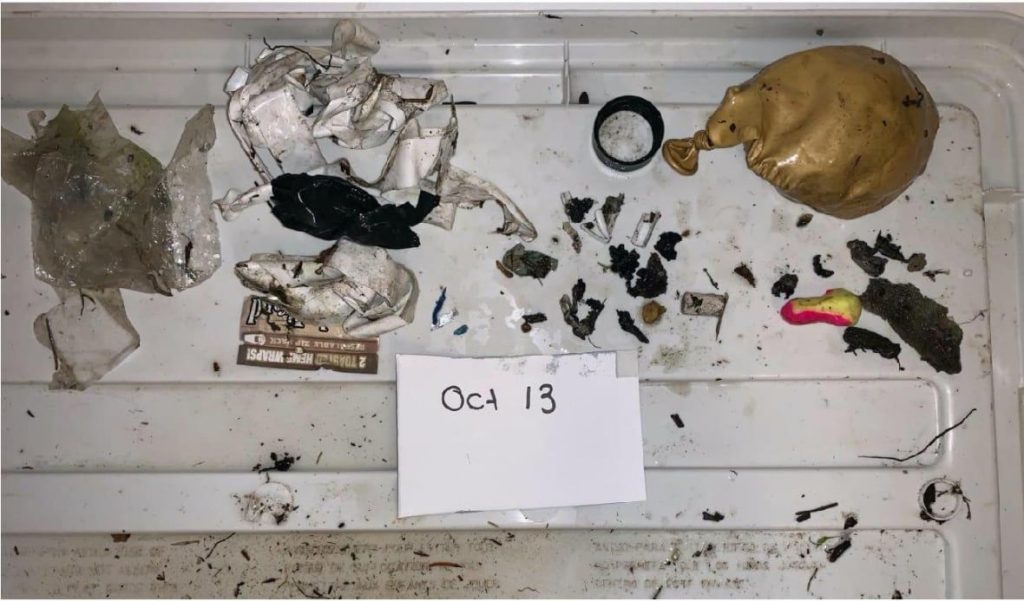The world’s oceans provide over half of our oxygen, and they host life that plays critical roles in our aquatic ecosystems. Our planet’s fate relies on wise decisions we make and actions we take today. Plastic pollution is an enormous problem, however, it was overfishing that filmmaker Ali Tabrizi stressed in his 2021 documentary, “Seaspiracy.” He wanted to see pressure on world leaders to make 30% of our oceans “no-take zones” by 2030. Tabrizi revealed that discarded plastic fishing nets account for 46% of the Great Pacific Garbage Patch, which indicates that overfishing is indeed a pressing concern.

Melanie Abdelnour, left, and a student look at the contents of the Seabin at the Nepean Sailing Club. (Submitted by Melanie Abdelnour)
An estimated 50 million sharks are killed annually through by-catch alone, meaning that they’re scooped up accidentally while other fish are targeted. Whales are some of the ocean’s most fruitful gardeners. Their poop fertilizes the surface of the ocean with nutrients that are fundamental to the health of ocean ecosystems. Whales also bring nutrients up from the bottom of the ocean where they help phytoplankton to grow. Tuna, a sought-after delicacy, are a top predator, maintaining a balance in the ocean environment. The ocean’s ecosystems are dependent on the large fish governing the top of the food chain.
Out of concern that fishing be sustainable for the many communities that depend on it for their livelihood, Tabrizi criticizes current fishing subsidies and the weak enforcement laws for sustainable fishing methods. Despite the waves that the documentary made, there is consensus among climate scientists and marine biologists that the health of our oceans is in decline and we must reduce our consumption of seafood. Restaurants have a great opportunity to be leaders by offering fewer fish selections. For example, the seafood chain, Long John Silver, has begun by testing plant-based sea-inspired options of crab cakes and fish fillets.
Renowned environmental filmmaker, Sir David Attenborough stated, “Repopulations of the oceans can happen within a decade if we have the will to do it—but we require everyone to agree on it.” As Attenborough realizes that his generation has failed, he now spends more time focusing on educating the youth.
Our Great Lakes, the largest freshwater system in the world, also endure plastic litter, microfibres from laundering, diesel oil, and noise pollution. During COVID they have been put into further jeopardy by an increased amount of discarded plastic. In Lake Ontario alone, volunteers for A Greener Future witnessed a much larger increase of littered single-use plastics including masks, sanitizer wipes, gloves, and disposable takeout containers with cutlery, all known as personal protective equipment (PPE). When left lying on or around beaches, these items enter lakes and can last virtually forever, eventually becoming microplastics, which subsequently are ingested by fish and found in our drinking water.
Founded in 2014, A Greener Future, a non-profit organization, works within local communities to promote environmental protection through organized litter cleanups, educational programs, and events.
Rochelle Byrne, Founder and Executive Director of A Greener Future, stated, “Last year through our ‘Love Your Lake’ program, we picked up a few pieces of PPE along Lake Ontario’s shores but this year we are finding it at almost every cleanup. It’s very hard to see this huge increase in such a short time especially since the impacts can be long-term. I’m so grateful for the many dedicated volunteers, half of whom were students, helping to keep this debris out of the environment.”
In total, “Love Your Lake” volunteers from Kingston to Niagara Falls picked up an estimated 110,000 pieces of litter that included 463 pieces of PPE. This resulted in over a 635% increase of PPE litter recorded as compared to 2020. This yearly cleanup has demonstrated that landfill sites and lakes are being polluted at never-before-seen levels. Byrne added that they have incorporated a litter art program, launched a school community service hours program (agreenerfuture.ca/high-school-hours), and an opportunity to study data collection and community engagement, all intended to raise awareness through our passion to protect our lakes.

A snapshot of debris caught by the Seabin placed in the Ottawa River. (Submitted by Melanie Abdelnour)
The Ottawa River’s polluted condition caught the attention of Melanie Abdelnour, a grade one teacher for the Ottawa-Carleton School Board. In 2020, she helped introduce Seabin—a small bucket-like innovation equipped with a mesh filter catch bag that gathers surrounding water along with litter, then pumps the water back into the river. Originally designed in Australia, Seabins exist in waterways of yacht clubs and marinas in more than fifty countries. Presently, one floats at the Nepean Sailing Club’s dock from May to November where it filters out diesel oil and traps an estimated 5,600 to 9,200 pieces of debris, including seaweed that contains microplastics.
Local engineering firm Geniglace Inc. and Deep Blue Cleanup partnered to acquire Seabin for use in the river. Research on this summer’s debris is being analyzed by Carleton University student Vanessa Fior . Information is also being shared with the University of Toronto’s trash team, a science-based community outreach group. Abdelnour also sees the amazing little bucket as an educational tool. She states, “This is the first trash-trapping device in Ottawa and it gives us an opportunity to see what’s happening in our water. If kids come and see for themselves, they’ll be more likely to take care of their waterways. Next spring, we hope to have field trips three times a week and get students to analyze the pollution. If kids are not involved, we’ll keep putting garbage in our water.”
Abdelnour is aiming to encourage more educators in Ottawa to get on board with the project. Teachers in all cities with harbours could push for community partnership to maintain their life-saving waters.
Teachers can prepare now for conducting spring water experiments by checking out Water Rangers. This Canadian non-profit group visits schools that will provide educators with easy-to-use water testing and data sharing tools to help their students protect water bodies.
Viewing environmental documentaries, conducting tours, creating litter art, cleaning beaches, studying biology, testing water samples, analyzing data, as well as choosing non-seafood meals are all efforts where teachers can engage youth. Students have the best opportunities to form clubs and become forceful teams, large or small, in creating change.
Related Links
www.agreenerfuture.ca/love-your-lake-2021
www.agreenerfuture.ca/blog/2021/6/19/how-the-environmenthas-fallen-victim-to-ppe
www.totallyveganbuzz.com/news/long-john-silvers-goodcatch-first-vegan-fish-items/
www.cbc.ca/news/canada/ottawa/seabin-ottawa-nepeansailing-club-microplastics-pollution-1.6093403
www.cbc.ca/news/canada/ottawa/ottawa-river-microplasticstudy-1.3734042
meadowview.ucdsb.on.ca/for_students/get_involved/clubs/eco_schools/turning_trash_into_school_cash_
www.consumerreports.org/environment-sustainability/how-to-quit-plastic/
https://waterrangers.ca/testkits/shop/
ABOUT THE AUTHOR
Larraine Roulston
Larraine writes children’s illustrated adventure books on composting and pollinating. To view, visit: castlecompost.com
This article is featured in Canadian Teacher Magazine’s Winter 2022 issue.












